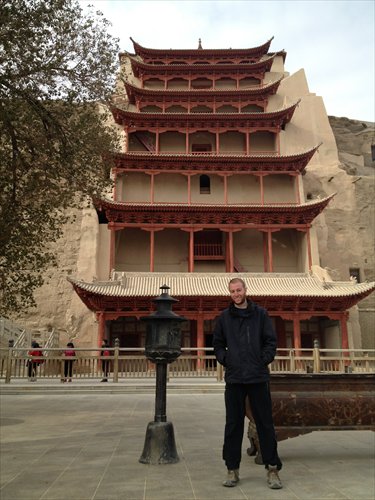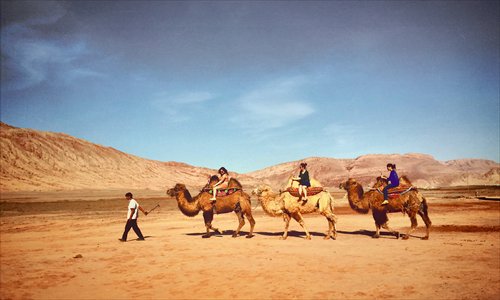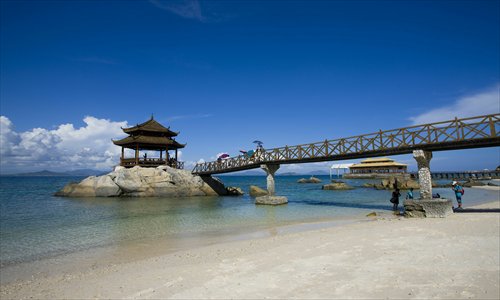Past meets present in rich scenery and culture along on the Silk Road

Jacobs is swept away by the rich history and culture in Dunhuang Mogao Grottoes, Gansu Province, which is along the Silk Road. Photo: courtesy of Ben Jacobs
Standing among 2,000 years of history, Ben Jacobs, a 25-year-old American who works for a consulting company in Shanghai, felt he was having a personal conversation with ghosts of the past in the silent and abandoned Jiaohe Ruins in Turpan, the Xinjiang Uyghur Autonomous Region. This section of the ancient Silk Road pass holds the world's oldest and the most well preserved raw-soil-building city.
Always a tourist attraction for people who love the exotic flavor of the centuries-old historic site, Jiaohe Ruins has seen an even increasing number of foreign tourists in recent years, after the site, along with the Silk Road, was included in the One Belt, One Road initiative.
"The main reason I visited the Silk Road is that I believe the One Belt, One Road initiative would change the local conditions and I wanted to see it before everything was different," said Jacobs, who has been living in China for 3 years. Jacobs' route along the Silk Road took him through Xi'an in Shaanxi Province, Dunhuang in Gansu Province, Turpan and Kashgar in Xinjiang and then through Kyrgyzstan, Uzbekistan and Turkmenistan.
Jacobs made the journey along the Silk Road with his friend last fall. Before they left, he did some research online and read books about Silk Road history, such as Cultural Perplexity in Agonized Travel, by Yu Qiuyu.
"The way Yu describes the Buddhist paintings as embodying the essence of each Chinese dynasty is amazing," described Jacobs. Carried by his excitement and expectation, Jacobs set off to the land of the Silk Road. "I was overwhelmed by the intricacy of each cave I passed through."
A recent report released by ctrip.com, one of China's largest online travel agencies, said that scenic spots along the One Belt and One Road have become a new highlight in inbound tourism, attracting more tourists to China to visit the historical area, according to a Xinhua News Agency report in May.
The Silk Road Economic Belt and the 21st Century Maritime Silk Road are known as One Belt and One Road respectively. Each of the routes hosts many places of historic interest and natural beauty.
The One Belt covers the areas between China and surrounding countries in West Asia that cover almost all of the ancient Silk Road. The lands include Northwest China's Shaanxi, Gansu and Qinghai provinces, the Ningxia Hui Autonomous Region and Xinjiang; Southwest China's Chongqing municipality, Sichuan and Yunnan Provinces, and South China's Guangxi Zhuang Autonomous Region. The One Road includes East China's Fujian Province and South China's Guangdong and Hainan provinces.
With beautiful scenery, historical cultures, as well as policy support by government alongside the One Belt and One Road, travelers not only encounter a journey of history and culture, but witness the growth of the Chinese tourism industry as well.

The beautiful scenery in Flaming Mountains impressed Scalora along her Silk Road trip. Photo: courtesy of Alina Scalora
A scenic route through history
For Jacobs, ancient Chinese history and old architecture is a passion. Taking trains along the Silk Road in China, Jacobs was impressed by the expansive and imposing view of the western regions, including the artwork at Mogao Grottoes in Dunhuang, with nearly 500 temples of collections.
"Its age, intricacy and the way paintings from cave to cave shifts in philosophy and time amazes me," he said. "The towering statues of Buddhist deities, the gigantic maps of temple complexes on the walls; it's an ode to the vivacity that Buddhism has injected into Chinese history and culture."
"Staggering" and "rich" are two words Alina Scalora used to describe the breath-taking landscape along the Silk Road. Scalora, a 29-year-old American who has been living in China for five and a half years, visited Xinjiang for a week in 2015.
Flaming Mountains [located north of Turpan Basin] is one of her favorite locations. Before she set off, Scalora believed she could tough it out in one of the hottest places in China since she lived in Wuhan, Hubei Province, which is widely known for its scorching temperatures in the summer .
"I thought it would be a breeze since everyone said Wuhan is one of China's four furnaces and I survived it for half a year," she said. "When I got to the Flaming Mountains, my skin felt like it was burning off. People were outside frying eggs on the ground just to see if they could."
Scalora was only able to stay there for 15 minutes to take some pictures. "It's mind-boggling that locals can work there for the entire day!"
She said that although Flaming Mountains is hot, its beautiful scenery impressed her and became one of her favorite scenic spots along her trip.
Steven Neo, who hails from Singapore, said he is a fan of history, culture and adventure. He visited Quanzhou, Fujian Province, in October 2015.
His favorite scenic spot is Kaiyuan Temple. Kaiyuan Temple is one of the most important cultural relics and historic sites along China's southeast coast. It showcases historical architecture with deep ties to the maritime adventures of Zheng He, who was a seafarer and diplomat in the Ming Dynasty (1368-1644).
"After my trip, I have a deeper appreciation of the adventurers of the maritime Silk Road, and how my own heritage [in Singapore]is closely related to the men and women who lived and worked [here] centuries ago," he said.

Government in Hainan Province strengthens maritime Silk Road traveling cooperation. Photo: IC
Challenges during the trip
When Scalora visited Xinjiang, one of the challenges she faced was the language barrier.
To expats, even if you speak Chinese well, it will not work there, "not many people speak Chinese in Turpan and if they did, it was difficult to understand," she said. "Luckily people were kind and patient, problems can be solved via body language and pointing."
Doing research beforehand can pay off big for visitors. Scalora said many places can't be reached by plane or tram; travelers should know and plan well on how to get from one place to another.
Keeping healthy is important for safe travel as well, and Scalora suggests travelers shouldn't overlook staying hydrated. "The elevations are high and some places are extremely hot. When you are out having the adventure of a lifetime, it can be hard to remember something as simple as drinking water."
Doing research beforehand includes finding out about local culture. For Jacobs, he met such a challenge when carrying alcohol on the street in Xinjiang.
"For Muslims, drinking is forbidden," he said. At that time they were carrying beer bottles but not drinking, however, a guy on a motorcycle scolded "No" to them.
"It was a weird moment. He didn't speak English or Chinese, so he had no way to express himself. Then we remembered we had beers in our hand, and then we were pretty certain he was scolding us for having beer out. We just figured walking home and not actually drinking them would not be a problem, but we were wrong."
A bright future
"The Silk Road is popular among foreign visitors that want to know more about Chinese history and culture, but not many of them are interested in the coastal cities along the maritime Silk Road," an employee from a travel agency based in Fuzhou, Fujian Province, told Metropolitan.
The China National Tourism Administration announced 2015 was "the year of Silk Road tourism," and began to implement the Belt and Road initiative in the tourism industry.
Cities along the maritime Silk Road are also looking for ways to promote their strength in the travel industry. Zhu Hua, the director of Fujian tourism administration said that Fujian would launch new maritime routes to promote their cruise tours, according to the China National Tourism Administration on April 1, 2015.
"People from countries along the Chinese maritime Silk Road, with a similar culture background, may have more interest to travel this area. The travel agency should understand visitors' interests to make the best traveling routes for them," the employee said.
Li Jinzao, the head of China's National Tourism Administration, said in a conference that China plans to send 150 million travelers along the One Belt and One Road. He said in the next five years, $200 billion are expected to be spent by the tourists, which will raise travel expectations among countries along the ancient Silk Road, the voice of America reported on June 3, 2016.
Scalora was aware of the government wanting to bring more tourism along the One Belt and One Road.
"I do believe this can be a good thing in helping stimulate the local economy by providing more jobs, while also bringing in more funding to restore its local sites and historical artifacts. I believe if infrastructure is improved, you'll definitely see an increase in tourism along the Silk Road," she said.
However, she had concerns about crowds of tourists causing the area to lose its charm and peacefulness. "I hope economic prosperity does not equal a loss in local culture. It will need conscious effort from both local government and residents [to maintain its current charm]," said Scalora.
Newspaper headline: A journey: One Belt and One Road